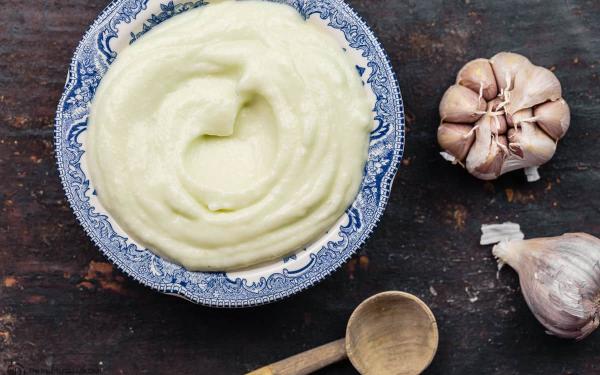Garlic (Allium sativum) is a flowering plant that is closely related to onions, shallots, leeks, and chives. It is native to central and south Asia, but also grows wild in areas around the Mediterranean where it was introduced around 3000 BC[1][3]. Garlic was widely used in the Middle East by members from all social classes as a food seasoning, medicinal ingredient, and religious or cultural symbol[3].
Garlic grows best in loose, dry, well-draining soil in sunny locations. It prefers soil with high organic content, but is able to tolerate a range of soils and pH levels. Garlic can be planted closely together, but grow larger when spaced adequately. Additionally, because garlic grows by planting individual cloves, planting a larger clove will likely yield a larger bulb at harvest. Garlic grows best when its scapes (immature flowers) are removed as they begin to curl, allowing the plant's energy to redirect toward bulb growth[1].

Cultural Relevance of Garlic
Garlic has been used for traditional medicine in various cultures throughout the ancient world[1]. Its antimicrobial and anti-inflammatory properties made it a popular medicinal herb, as well as its use in supporting the immune system and aiding in physical exhaustion[2]. The Ancient Egyptian Ebers Papyrus lists 22 garlic prescriptions for ailments, including its use to prevent gangrene, repel scorpions, treat dog bites, cure asthma, protect against leprosy, and more. Garlic was also believed to be a direct source of strength, and was frequently fed to the slaves building the pyramids for this reason[3][4]. Garlic was also important to Jewish medical traditions, as the Talmud states that garlic has five primary properties; it satiates, warms the body, brightens the face, increases fertility, and combats intestinal parasites[5]. During the Middle Ages, garlic was used frequently in both Monastic and Islamic medicine to treat the common cold, senility, menstrual disorders, impotence, and even cancer[4].
Today, there isn’t much (if any) evidence that garlic can cure or prevent diseases. However, it does maintain antimicrobial and anti-inflammatory properties, and is still used as a remedy for colds in many areas of the world (although not typically prescribed by a doctor).
In celebration of Nowruz, the Persian New Year, garlic is one of the essential items in Haft-sin (7 things beginning with S), as the Persian word for Garlic is pronounced as “seer”[1]. It is meant to symbolize health and medicine, as it was traditionally prescribed in Persian medicine for respiratory infections, digestive issues, and as a general health tonic[5].
In Ancient Egypt, it was believed that garlic could prolong life and increase strength. Garlic and clay sculptures of garlic bulbs have been found in various ancient tombs, including the tomb of King Tutankhamen’s where garlic was found very well preserved in clay pots[3][4]. Garlic was frequently used as an offering to gods, was buried with the dead to accompany them in the afterlife, and was also used to prepare bodies for burial[4][5]. Garlic also had a variety of medicinal uses, as the Ebers Papyrus, an Ancient Egyptian medical text, listed 22 garlic prescriptions for ailments[5].
In Islam, there also various Hadith recommending that garlic should not be eaten raw prior to entering a mosque[1]. It was advised that whoever had eaten garlic should keep away from the mosque and remain in their home. Despite this, it remained an important ingredient for many Islamic medicinal practices[5].
In Jewish tradition, garlic is one of the foods that the Israelites longed for while they were traveling from Egypt to the promised land (Numbers 11:5). The Talmud also provides insight into the medicinal and dietary roles of garlic, where its consumption was especially recommended on Friday evenings to enhance vitality. In addition to health benefits, it was also believed to ward off the ‘evil eye’ and protect against evil spirits[5].
Christians in the Middle Ages also believed that garlic would ward off evil spirits and disease, and was frequently used in religious rituals. It was also a central ingredient for Monastic medicine, practiced by Christian monks throughout Europe and the Middle East[5].
Garlic is widely used around the world for its pungent flavor as a seasoning or condiment. The most commonly used part of the plant is the bulb (made of cloves), but the flowers and leaves can be eaten as well. These parts are often eaten before maturity, where they are still tender and have a more mild flavor. In the Middle East, garlic is often used in combination with oils and other ingredients to create sauces and dips, such as Toum and Hummus[1]. It is also a common ingredient in stews, rice, and savory dishes. It is most frequently used minced or sliced, and then sautéed, roasted or grilled for a mellow aromatic taste, subtle sweetness or an enhanced charred flavor. It can also be used raw, especially for dips like aioli and tzatziki. Garlic can also be fermented to add more complexity to its flavor[2].



